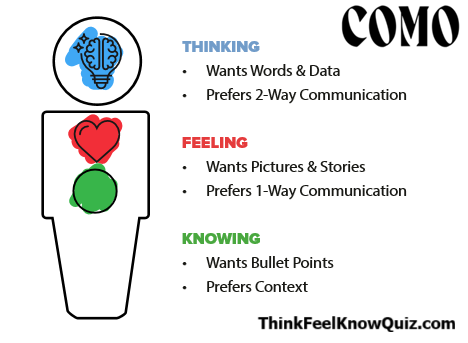What is your Decision Making Style? In Blackboard Fridays Episode 54, Jacob talks about Leadership. Need this implemented into your business? Talk to the international business advisor who can do exactly that – Contact Jacob, Learn More, or Subscribe for Updates.
SHOCK! HORROR! It turns out, people are different!
OK, sure, it’s hardly a revelation – but when you understand some of the key ways in which people differ, it makes you much more effective as a business leader and a team member.
This week’s episode explains the tool I use most often with teams to help them understand their own communication style and decision-making preferences … and those of their colleagues.
It’s called Think Feel Know – and you can test yourself for free by clicking here. Think Feel Know works better than other tools I’ve used because it’s behavioural (this is how you’re showing up at work, it’s not who you are as a person) and it’s inclusive (we all make decisions in all three spaces, so we can find common ground).
Watch this week’s episode to learn more, and ask yourself: Are you a Thinker, a Feeler, or a Knower? What about your leadership team?
PS: Worried about decision-making in your leadership team? Contact me to learn more about Leadership and Culture strategy workshops, tailored to your business.
Who is Jacob Aldridge, Business Coach?
“The smart and quirky advisor who gets sh!t done in business.”
Since April 2006, I’ve been an international business advisor providing bespoke solutions for privately-owned businesses with 12-96 employees.
At this stage you have proven your business model, but you’re struggling to turn aspirations into day-to-day reality. You are still responsible for all 28 areas of your business, but you don’t have the time or budget to hire 28 different experts.
You need 1 person you can trust who can show you how everything in your business is connected, and which areas to prioritise first.
That’s me.
Learn more here. Or Let’s chat.
Transcript
I’ve got some shocking news for you. Not everybody in the world is exactly the same as you are. In fact, if you’re a business owner, you are in a minority of crazy individuals who decided to go and start a business, run a business. As a leader in business, it’s critical that you understand both from a self-awareness perspective, some of the things that make you different, and also have the tools in your leadership toolkit to understand what drives and motivates your team.
This week, we’re looking at the framework I use when I do leadership training to look at decision making and communication preferences. We call this Think, Feel, Know. We all make decisions in three areas; however, we tend to have a preference for one over the others, and when we just apply our preference into the wider community, we often create frustration and miscommunication with people who come at it from a different approach. So, let’s go through and hope you understand the Think, the Feel, and the Know to work out what your preference is and to see how you can apply this in your team.

Let’s start at the beginning. Where in your body do your associate thinking? Most people answer that question talking about their brain. So, in a thinking space, we want words and data. The communication tends to be two-way dialogue, lots of questions and answers, back and forth. If you think about buying something technical, maybe an iPhone or a laptop computer or a car or if you’re not a car buff, you’ll want to get into that data, and you will often make that decision in a thinking space.
In a feeling space, it’s a different process. Where in the body do we associate feeling? Of course, it’s in the body or often, draw that as the heart. We make a decision in the feeling space and we want more pictures and stories. Emotions work better with one-way communication either of us talking something out, or having pictures and stories watch over us. It’s why when you go to the cinemas, you have a much more emotional reaction than if you sit there and watch something on the telly while playing with your phone.
The one-way communication gets you into your feelings. If you think about when you go to dinner and you need to make a decision about what to eat, nobody says what do you think like for dinner or what do you feel like for dinner. We all have all of these three, and this is what separates Think, Feel, Know from similar tools like Myers-Briggs, disk–those kind of approaches that tend to say you are either or. With this, we are all all three and that means we’re in a position to better understand people who are not like ourselves.
The third area is our knowing. Our gut feels and our intuition. You make intuitive knowing decisions it tends to be very quick. The communication style needs to be bullet points. It’s all about context. That gut feel is what drives so many entrepreneurs and business owners to go out there and to make a decision. You can’t think through every aspect of business. You need to make some fast decisions, take some risks, and feel comfortable doing with. And so, the challenge for a lot of business owners is that they will often employ thinkers or feelers who then get frustrated when you as the business owner make all of those knowing, intuitive decisions.
So, which of those three is your preference? Are you primarily a Thinker, a Feeler, or Knower? Think about your spouse or partner. Which is their preferred decision-making style? Think about key team members or key clients. You could run this exercise a hundred times and we’ll give you a link at the end of this video to actually go online and do the diagnostic indicator to give you an idea of not just which is your primary, but how strongly you have that preference such as what’s your percentage across think, feel, and know.
Because by having all three, by understanding the strengths of those that we work with, we have the opportunity to connect with them in their decision making style. If I as a business owner, and quite knowing and intuitive, but my business partner or my CFO is quite analytical, I know I need to communicate with them there to get the outcomes that I want. Ideally, we can find a middle ground.
I’ll give you one last example of where I see this causing so much frustration and where the opportunity really lies. It’s when you’ve got a leadership team. Perhaps a board, a group of individuals tasked with making key decisions who have different preferences for decision making styles. You’ve got that analytical person who comes in with the words and the data, the spreadsheets, here are my recommendations and, here’s the detailed approach to how we’re going to tackle it. About 30 seconds in, the knower has already made their decision. They have the experience, the gut feels to go, “This is what we’re going to do.” They’ve tuned out.
The feelers want the time to process this. They’re trying to pay attention. They want to be respectful to the data that the thinker is providing, but by holding them in a data space, they’re not getting a chance to actually process it. They go along with the decision on the day, and come in next time in the next board meeting, and say, “Actually, no. No, I’ve changed my mind.” It’s not because they’re being difficult, frustration, it’s just that your process was not designed to give them the space that they need. It didn’t take into account all three decision-making styles.
When you can take all of that into account, you will find that you make better decisions, you communicate better decisions, and your team make the same decisions and come along on the journey with you.
Next Steps
Want to learn more about how this can apply to your business? It costs nothing to chat:
- Email me jacob@jacobaldridge.com (I read them all)
- Call, Text, or WhatsApp me +61 427 151 181
- Or just Subscribe https://jacobaldridge.com/about/subscribe-to-jacob-aldridge-com/ to stay in touch





[…] Episode 54 we discussed Think Feel Know, as a simple framework for understanding the three ways we all make […]
[…] looked at the impact of different Risk Profiles (Episode 13) and the Think Feel Know Decision Making Styles (Episode 54), I now want to introduce you to a tool that massively changed my business and personal […]